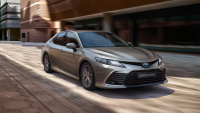The 2004 Toyota Camry business sedan was produced with a single body type for both Japan and foreign markets. The car was equipped with gasoline engines with a service life of more than 500,000 km.
Due to the large margin of safety and spacious interior, cars remain in demand in the secondary market (regardless of the location of the steering wheel).
2004 modifications
The 2004 model year cars were offered with a 4-door sedan body. Toyota abandoned the station wagon from the very beginning of the XV30 generation.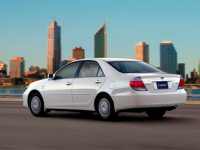 The basic equipment had four airbags, and some cars were equipped with curtain airbags. By default, the cars are equipped with electric heated front seats and rear-view mirrors.
The basic equipment had four airbags, and some cars were equipped with curtain airbags. By default, the cars are equipped with electric heated front seats and rear-view mirrors.
The manufacturer provided ultrasonic parking sensors in the rear bumper and a radio with a CD player. Traditionally, all assembled cars have 1-zone climate control.
The body is available in several paint options with metallic effect. The base model has a white color. Stamped rims were offered on machines with a 2-liter engine to a limited extent.
All other versions used light-alloy parts with the original design. For all markets the body was available with a hatch in the roof. The panel was electrically operated and had a decorative curtain rod to match the shade of the headliner.
The 3.0L version featured an expanded safety package, which included a stability program and wheel slip control. Driver and passenger seats could be electrically adjustable without position memory.
The European versions differed from the American versions in lighting and shock absorber stiffness, as well as units on the speedometer and thermometer scales.
Engines
Toyota Camry was equipped with only two engines, both gasoline: 2.4 liter 4-cylinder (152 hp) and 3-liter V6 with 186 hp. By the way, for U.S. versions, instead of 3.0-liter engine, a 3.3-liter V6 (228 hp) is available.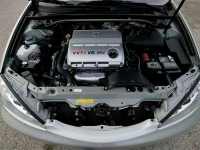 Powertrains have a phenomenal reliability. The "4" units have a strong metal chain in the camshaft drive. In V6 instead of it - a toothed belt, which is subject to regulation replacement after 150 thousand km, along with the rollers.
Powertrains have a phenomenal reliability. The "4" units have a strong metal chain in the camshaft drive. In V6 instead of it - a toothed belt, which is subject to regulation replacement after 150 thousand km, along with the rollers.
The alternator drive belt on the 2.4-liter engine in our conditions serves on average 60-80 thousand km. And the belt tensioner often fails. If you have felt, that the engine suddenly became noisier, than it was, with a specific rattle, hasten on service.
For preventive purposes it makes sense to flush the throttle block, air flow meter and idle valve - otherwise the engine will soon start working with interruptions and twitches.
Car Appearance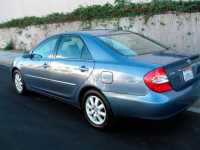 The car had a flowing body shape that combined elements of Asian and American design. The Camry XV30 did not sell well in Europe, forcing the company to concentrate on the North American and Middle Eastern markets.
The car had a flowing body shape that combined elements of Asian and American design. The Camry XV30 did not sell well in Europe, forcing the company to concentrate on the North American and Middle Eastern markets.
The interior of the 2004 Camry
The interior of the car has not changed from the previous model year. At the front of the cabin was installed a massive dashboard with grilles for fresh or heated air. The steering wheel had buttons to control the radio.
The multimedia center and climate control unit with a display were in the center of the panel. Between the front seats was a console with niches for storing small items and an armrest.
The interior is finished with wear-resistant materials and some elements are made of foam plastic. The center console, the dashboard and the door cards imitate polished wood.
The seats are upholstered in velour or leather, the headliner is made of foam multilayer material that absorbs extraneous noise.
Exterior design
The exterior of the 2004 model year was not updated. The cars kept the narrow headlights with separate lamps for low and high beam, equipped with a plastic diffuser (glass was available for Europe).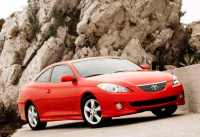 There was a sensor for automatic control of lights. Massive plastic bumper had windows to install fog lights.
There was a sensor for automatic control of lights. Massive plastic bumper had windows to install fog lights.
The material could withstand a collision with a stationary obstacle at speeds up to 5 km/h. All trucks had bumpers painted in body color.
The long hood with integrated grille had a large angle of inclination, which improved aerodynamic quality of the body and visibility from the driver's seat.
On the side of the doors there was a convex part on the lower edge to protect the surfaces from the flow of dirt. Plastic trim panels protected the doors from damage when stationary.
The rear fenders had large combination lights. The trunk lid of Japanese cars could be equipped with a spoiler painted in the same color as the body.
Technical characteristics of the 2004 Camry
The body of the car is assembled from separate elements connected by contact welding with additional protection of some of the joints with sealant. At the base are box spars, the power cell of the saloon is reinforced by elements of alloy steel.
The body is designed to install both front and side airbags.
A hydraulic steering rack was used. The amplification coefficient was determined by the speed of the vehicle.
Engine and transmission
In-line 4-cylinder engines were available, as well as V6 engines. All engines were designed to use unleaded gasoline with an octane rating of 92 or higher.
There were two camshafts in the cylinder heads, each cylinder had a pair of intake and exhaust valves. For the American market, there was a version of the 3.3-liter engine with increased horsepower.
The 1AZ-FE engines were offered with a 5-speed manual transmission. A limited number of cars were made with 2AZ-FE engines and manual transmission.
The other power units were accompanied by 4-speed hydraulic automatics (boxes had design differences depending on the volume of the engine).
European and American versions had front wheel drive, in Japan, the Camry Four was sold with all-wheel drive (internal code ACV35).
All-wheel drive was the same as front-wheel drive models.
The transmission included a transfer gearbox with a viscous clutch.
Torque was transmitted to the rear hubs by the driveshaft, auxiliary gearbox and half-axles. The all-wheel drive system was automatically engaged when the front tires slipped (for example, on ice or wet ground). The viscous clutch could not be engaged or disengaged.
Running Gear
Suspensions are mounted on steel sub-frames, which are bolted rigidly to the body side members. To mount the front wheel hub, an articulated arm with ball and socket joints is used. The suspension includes a non-linear stiff spring and a McPherson type hydraulic shock absorber.
Levers are used at the rear, and wheel alignment is adjustable. Both suspensions have anti-roll bars with ball stud struts.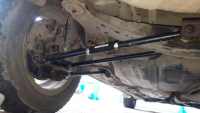 Fuel consumption
Fuel consumption
Depends on engine displacement, driving conditions, loading and overall technical condition. According to owners' reviews, on the highway cars need 7-8 liters of fuel per 100 kilometers (at speeds up to 110-120 km/h).
In urban conditions, at positive air temperatures the engines burn from 11 to 14 liters (with air conditioning and traffic). In winter, the parameter increases by 1-2 liters due to the need of warming up or driving on snowy roads.
Advantages and disadvantages
The main advantages include:
high reliability of the units;
low cost of consumables and spare parts;
extended set of options included in the basic equipment;
soft suspension, which smoothes the irregularities of the road surface;
roomy interior and luggage compartment.
Disadvantages of the car:
high gasoline consumption;
simplicity of the interior and exterior;
low efficiency of braking mechanisms;
poor illumination of the road with headlights;
roll of the body when sharply changing the line or turning at speed;
insufficient strength of the radiator, which is punctured by stones;
low service life of front brake discs.
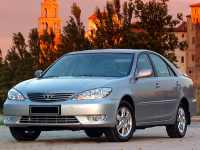

-rear-and-front-view-camera-6.png)
